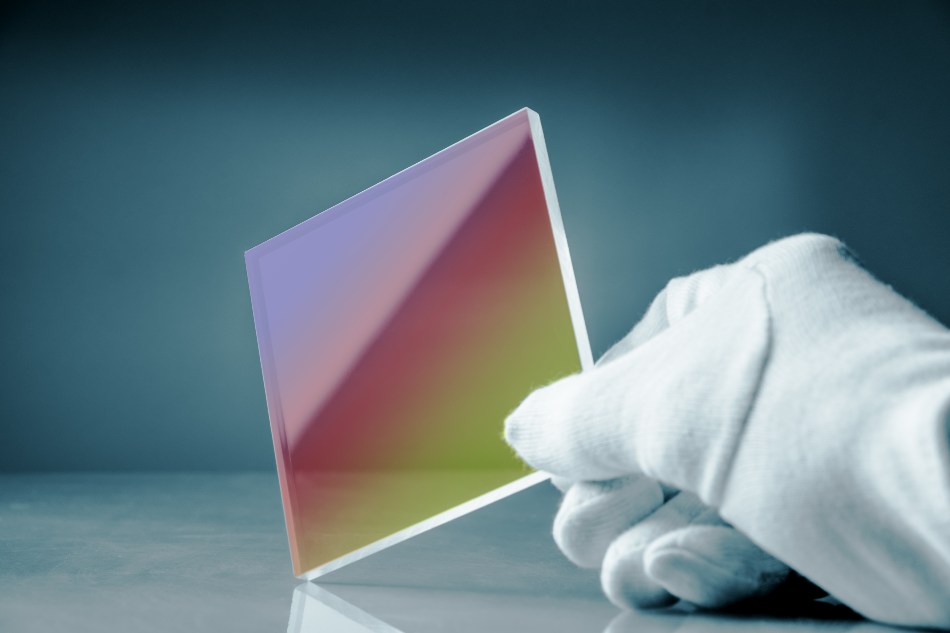
Thin-film optics is the branch of optics that focuses on thin, structured layers of different materials. These layers range from a fraction of a nanometer up to several micrometers thick but are usually in the order of the wavelengths of ultraviolet light, which is about 500nm. Their synthesis is controlled via deposition, with one or more layers of material layered onto the substrate, usually via physical vapor deposition.
Optical coatings
Optical coatings assist in reflective and refractive systems; think of refractive lenses, or a household mirror, which has a thin metal coating on the back of a sheet of glass to form a reflective layer. By controlling the thickness and density of the coating, it is possible to decrease the reflectivity and increase the transmission of the surface.
Optical lenses such as those found in cameras and microscopes often have defects or aberrations, meaning light is spread out over a large region rather than being focused to a point. This leads to blurred and distorted images. To combat this, the lenses are coated with thin, transparent multilayers of metals such as titanium dioxide, silicon nitride, or silicon oxide.
Aluminum is the most common, and cheapest metal used; it reflects between 88 and 92% of the visible spectrum. Silver reflects between 95 and 99% of light, even into the far-infrared part of the spectrum, but suffers decreasing reflectivity in blue and ultraviolet regions. The most expensive metal is gold, which possesses excellent reflectivity of between 98 and 99%, even throughout the infrared portion of the spectrum.
These thin layers are deposited on the lens or mirror and alter the way the optic reflects and transmits light. For example, anti-reflection coatings reduce unwanted reflection on glasses and photographic lenses, while high reflector coatings for mirrors reflect greater than 99.99% of the light that focuses on them.
History
Advances in thin-film deposition during the 20th Century have led to some amazing technological breakthroughs, including magnetic recording media (floppy disks and magnetic strips on credit cards), electronic semiconductor devices, LEDs, optical coatings such as anti-reflective coatings, thin-film solar cells, and thin-film batteries. However, their history dates back thousands of years.The earliest documented purposefully made inorganic thin films were gold layers employed in decorative and later optical applications by the Egyptians during the middle Bronze Age over 5,000 years ago. The films were gilded on copper and bronze statues, jewelry, and religious artifacts using mercury-based compositionally graded interfacial adhesion layers.
The first thin films grown from the vapor phase were likely metal layers accidentally deposited on ceramic pots and rocks surrounding hot charcoal fires being used to reduce metal ores. The earliest reported purposeful growth of metal films from the vapor phase was in 1649 when Johann Schroeder found a method for reducing arsenic oxide with charcoal.
Physical vapor deposition (PVD) describes several vacuum deposition methods and is characterized by a process in which the material transforms from a condensed phase to a vapor phase and back to a thin film condensed phase.
The most common PVD techniques are sputtering and evaporation, which was developed in the mid to late 1800s. These techniques were only made possible following the evolution of the vacuum and electrical power technology in the mid-1600s. Sputtering involves ejecting material from a source onto a substrate; the first publication of sputter deposition of thin films was in 1852, and the first documented evaporation experiments in the early 1870s and 1880s. This technique requires the evaporation of a source material in a vacuum, where the particles travel directly to the target and condense back to a solid-state.
Optical thin-film history can be traced back to 1912 when Robert Wichard Pohl and Peter Pringsheim first published their work about the production of mirrors; they vaporized metals like gold and aluminum in a high vacuum. In 1817, German scientist and optician Joseph von Fraunhofer first discovered the anti-reflection effect of a single layer on glass. These early coatings were likely to be dielectric and still represent a major portion of the coatings sector; they are used over the whole optical spectrum in things such as glasses and lenses.
By the 1930s, aluminum was being used as a reflective surface for astronomical telescopes thanks to its high reflectivity. However, silver, which was traditionally used, is now making a comeback as it has higher reflectivity and low emissivity.
Conclusion
As long as there are optical systems, optical coatings will be necessary; this enabling technology allows an optical system to perform at its maximum potential.
